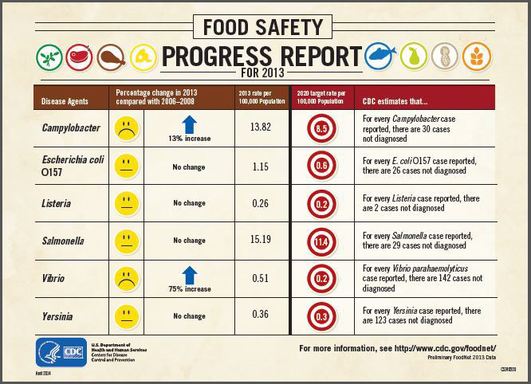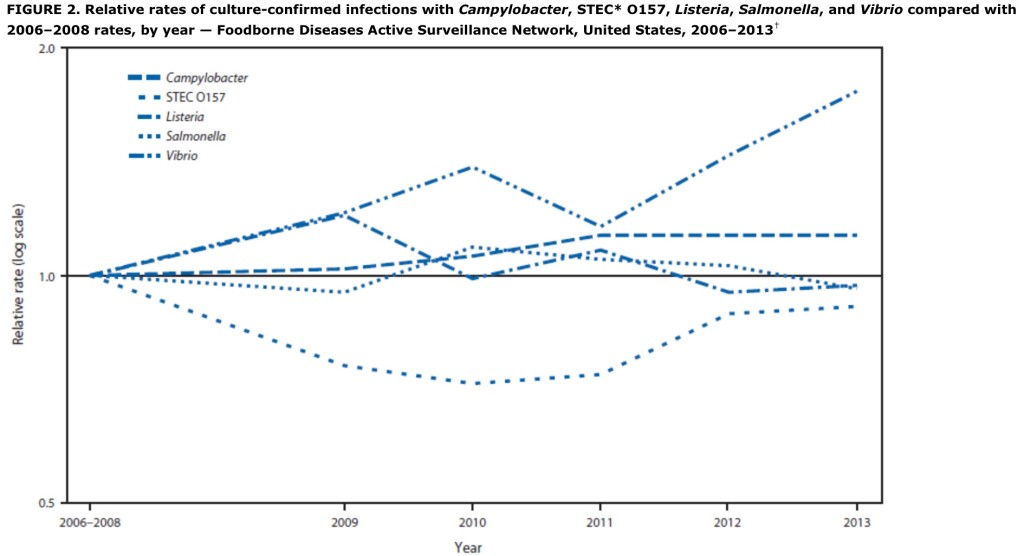FoodNet Canada tracks enteric diseases (illnesses of the gut) commonly known as food-poisoning, in Canadians and traces them back to their sources, such as food, water and animals. These data are analyzed to help determine which sources are causing the most illness among Canadians and help us to track illnesses and their causes over time.
 In the 2010 surveillance year, FoodNet Canada was active in two areas: the Region of Waterloo Public Health and the Fraser Health Authority of lower mainland British Columbia (BC). In each location, or “sentinel site”, enhanced human disease surveillance is performed in parallel with active surveillance of the possible sources that ill persons may have been exposed to, to determine if they contain specific bacteria, viruses and parasites that could cause illness in humans.
In the 2010 surveillance year, FoodNet Canada was active in two areas: the Region of Waterloo Public Health and the Fraser Health Authority of lower mainland British Columbia (BC). In each location, or “sentinel site”, enhanced human disease surveillance is performed in parallel with active surveillance of the possible sources that ill persons may have been exposed to, to determine if they contain specific bacteria, viruses and parasites that could cause illness in humans.
The following key findings are based on the surveillance data from 2010 in the ON and BC sites. However, no historical comparisons could be made for the BC site since the site was not established until April 2010.
*In the ON site, a higher number of human cases of enteric disease (acquired within the country) were reported in 2010 than in 2009, although rates have remained relatively stable over the last five years for most enteric diseases reported to FoodNet Canada. However, rates of verotoxigenic Escherichia coli (VTEC) infection and yersiniosis have both decreased since 2006.
*Campylobacter jejuni was the most commonly reported enteric disease (acquired within the country) in both sites. It was most commonly found on raw, retail chicken breasts purchased in the ON site. This highlights the importance of safe cooking and food handling practices. Contact with pet dogs was also more commonly reported in people with campylobacteriosis than in people with other reported diseases in both sites. In addition, Campylobacter was found in samples of animal feces collected from participating farms in the ON site. Overall, raw chicken was the most likely source of Campylobacter infection of all tested potential sources.
 *Salmonellosis was the second most commonly reported enteric disease (acquired within the country) in both sites with chicken appearing to be a main source for human illness caused by Salmonella. In the ON site, Salmonella was commonly detected in raw chicken and, rarely, in beef and pork. It was also found in fecal samples from broiler chicken, swine, beef, and dairy farms and in untreated surface water. The most common Salmonella subtypes (e.g. Salmonella Enteritidis phage types 8 and 13a) were similar among affected people, retail chicken meat and on chicken farms. In addition, exposure to pet cats was more likely for people with salmonellosis compared to other diseases in both sentinel sites in 2010.
*Salmonellosis was the second most commonly reported enteric disease (acquired within the country) in both sites with chicken appearing to be a main source for human illness caused by Salmonella. In the ON site, Salmonella was commonly detected in raw chicken and, rarely, in beef and pork. It was also found in fecal samples from broiler chicken, swine, beef, and dairy farms and in untreated surface water. The most common Salmonella subtypes (e.g. Salmonella Enteritidis phage types 8 and 13a) were similar among affected people, retail chicken meat and on chicken farms. In addition, exposure to pet cats was more likely for people with salmonellosis compared to other diseases in both sentinel sites in 2010.
*The rate of VTEC infection increased slightly in 2010 in the ON site (compared to 2009), however, this increase is within the normal variation that we would expect from year to year. Several of the studied exposure factors were reported more often by cases with VTEC infection than by cases with other enteric illnesses, such as eating at a restaurant. These findings highlight areas for further research to better understand potential exposure for infection. VTEC was found in fecal samples collected from beef, dairy, and swine farms in the ON site, as well as in 12 samples of retail ground beef and from untreated surface water. These findings are well known and expected and suggest that multiple sources of E. coli exist. Cattle remain a major source for E. coli O157:H7. Generally, meat products sold in the ON site have had low meat content from the region, due to processors obtaining their meat products from multiple regions of the province and Canada.
*Travel outside of Canada remains an important source of enteric disease in 2010, with 31% of the reported cases from the ON site and 24% of cases from the BC site likely involving infections acquired abroad. This highlights the importance of travel health information for Canadians.
To view the full report, please visit: http://publications.gc.ca/site/eng/461262/publication.html











